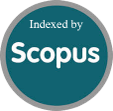Antimicrobial evaluation of two essential oils from Vaccinium corymbosum and Moringa oleífera leaves against Escherichia coli bacteria
DOI:
https://doi.org/10.51798/sijis.v3i2.332Keywords:
Óleos essenciais; atividade microbiana; inibição; Escherichia coli.Abstract
The use of essential oils has increased notably due to their bactericidal, fungicidal and antioxidant characteristics. The objective of this research was to evaluate the antimicrobial activity in a combination of the two essential oils in the control of Escherichia coli under in vitro conditions. The essential oils were obtained through the steam distillation method and subjected to decantation. 7 treatments and 3 repetitions were carried out, the treatments contain different percentages of the oils (T1:75%-25%, T2:50%-50%, T3:25%-75%, T4:100%-0%, T5:0%-100% T6: penicillin and T7: erythromycin) these last-mentioned antibiotics were witnessed and all the treatments contain 10 μl. The characteristics evaluated are the inhibition halos and the colony-forming units (CFU). An analysis of variance and the Tuckey test at 5% probability were applied. As a result, treatment 3 presented an average of 26.15 mm of inhibition halos and an average microbial load of 28.5 in (CFU) before the different treatments. In conclusion, it was evidenced that the combination of essential oils at 50% in both have a high inhibitory power against Escherichia coli bacteria in vitro conditions.
References
AL-Jabri, N. N., & Hossain, M. A. (2018). Chemical composition and antimicrobial potency of locally grown lemon essential oil against selected bacterial strains. Journal of King Saud University. Science, 30(1), 14–20. doi: 10.1016/j.jksus.2016.08.008
Cáceres, A., Cabrera, O., Morales, O., Mollinedo, P., & Mendia, P. (1991). Pharmacological properties of Moringa oleifera. 1: Preliminary screening for antimicrobial activity. Journal of Ethnopharmacology, 33(3), 213–216. doi:10.1016/0378-8741(91)90078-r.
Dinesha, B. L., Udaykumar-Nidoni, C. T., Ramachandra, N. N., & Sankalpa, K. B. (2018). Effect of extraction methods on physicochemical, nutritional, antinu- tritional, antioxidant and antimicrobial activity of Moringa (Moringa oleifera Lam.) seed kernel oil. J. Appl. Natural Sci. (IJANS), 10(1), 287–295.
Escobar, Y. N. (2018). Obtención de aceites esenciales mediante destilación por arrastre de vapor a partir del mucílago de cacao (Theobroma cacao L.). Milagro : Universidad Agraria Del Ecuador .
Evans, P. R., Bauer, K. M., & von Blotzheim, U. N. G. (1970). Handbuch der Vogel Mitteleuropas. Vol. 1. Gaviiformes-Phoenicopteriformes (1966). Pp. 484; black-&-white drawings; text-figures. Vol. 2. Anseriformes (Part 1) (1968). Pp. 536; 5 colour plates; black-and-white drawings; text-figures. Vol. 3. Anseriformes (Part 2) (1969). Pp. 504; 1 colour plate; black-and-white drawings; text-figures. The journal of animal ecology, 39(2), 552. doi:10.2307/2998
Fernández Sobrados, J., Pascual Chagman, G., Silva Jaimes, M. I., Salvá Ruíz, B., Guevara Pérez, A., & Encina Zelada, C. (2018). Efecto del tratamiento enzimático de la semilla de moringa (Moringa oleifera) sobre las características físico-químicas del aceite obtenido por extracción con prensa expeller. Scientia Agropecuaria, 9(3), 371–380.
Hernández, E. A., Abascal, V. L., Borges, R. M., Arana, O. E., García, K. G., Rivero, Y. H., & Jiménez, E. R. (2022). Evaluación farmacognóstica de extractos de hojas secas de Moringa oleifera Lam. del ecotipo criolla cultivada en Cuba. Revista Cubana de Plantas Medicinales, (3).
Jacome, J. J., & Canela,;. Evaluacion Del Efecto Bactericida De Aceites Esenciales De. (2019). Cinnamomum verum), JENJIBRE (Zingiber officinale) Y CLAVO DE OLOR (Syzygium aromaticum) PARA APLICACIONES AGROINDUSTRIALES. Quito.
Luengo, M. T. (2004). Los aceites esenciales. Offarm Ámbito Farmacéutico, 89. Recuperado el 14 de febrero de 2022, de Labohevea.com website: http://es.labohevea.com/downloads/HE_es.pdf
Maguna, F. P., Romero, A. M., Garro, O. A., & Okulik, N. B. (2006). Actividad Antimicrobiana de un grupo de Terpenoides. En Comunicaciones Científicas y Tecnológicas en Internet. Argentina: Facultad de Agroindustrias.
Martín, C, Martín, G, García, A, Fernández, Teresa, Hernández, Ena, & Puls, Jürgen. (2013). Potenciales aplicaciones de Moringa oleifera. Una revisión crítica. Pastos y Forrajes, 36(2), 137-149. Recuperado en 08 de febrero de 2022, de http://scielo.sld.cu/scielo.php?script=sci_arttext&pid=S086403942013000200001&lng=es&tlng=es
Nanasombat, S., & Lohasupthawee, P. (2005). Actividad antibacteriana de extracto etanólico crudo y aceites esenciales de especias contra Salmonella y otras entero bacterias. Investigación. Departamento de Biología Aplicada.
Neumayer, M. C. (agosto de (2015)). Introducción a la obtención de aceite esencial de limón. redalyc.org, 149-151. Obtenido de http://www.redalyc.org/articulo.oa?id=87701214.
Organización de las Naciones Unidas para la Agricultura y la Alimentación (FAO). Pérdidas y desperdicio de alimentos el mundo. Roma (Italia): 2015, 42 p
Prakash, B. et al. Plant essential oils as food preservatives to control moulds, mycotoxin contamination and oxidative deterioration of agri-food commodities – potentials and challenges. Food Control, 47, 2015, p. 381–389.
Risco, E., Miguélez, C., Sánchez de Badajoz, E., & Rouseaud, A. (2010). Efecto del arándano americano (Cysticlean®), sobre la adherencia de Escherichia coli a células epiteliales de vejiga: Estudio in vitro y ex vivo. Archivos espanoles de urologia, 63(6). doi:10.4321/s0004-06142010000600003
Shah, M.K. et al. Efficacy of vacuum steam pasteurization for inactivation of Salmonella PT 30, Escherichia coli O157:H7 and Enterococcus faecium on low moisture foods. Food Microbiology, 244, 2017, p.111-118.
Solís, A. J., & De; Estudio De La Actividad Antimicrobiana De Los Aceites Esenciales. (2016). ESTUDIO DE LA ACTIVIDAD ANTIMICROBIANA DE LOS ACEITES ESENCIALES DE: ALBAHACA (Ocimum basilicum L) Y CANELA (Cinnamomum zeylanicum) FRENTE A LA BACTERIA: Salmonella typhimurium.
Stansheko, E. (2009). ACEITES ESENCIALES. Recuperado de: http://cenivam.uis.edu.co/cenivam/documentos/libros/1.pdf
Vignola, M. B., Serra, M., y Andreatta, A. E. (2020). Actividad antimicrobiana de
diversos aceites esenciales en bacterias benéficas, patógenas y alterantes
de alimentos. Revista Tecnología y Ciencia, 18(37), 92-100. Recuperado el 14 de febrero de 2022, de Gov.ar website: https://ri.conicet.gov.ar/bitstream/handle/11336/132393/CONICET_Digital_
Downloads
Published
How to Cite
Issue
Section
License
Copyright (c) 2022 Junior Rodolfo López Engracia , María José Rodriguez Andaluz

This work is licensed under a Creative Commons Attribution-NonCommercial-NoDerivatives 4.0 International License.




